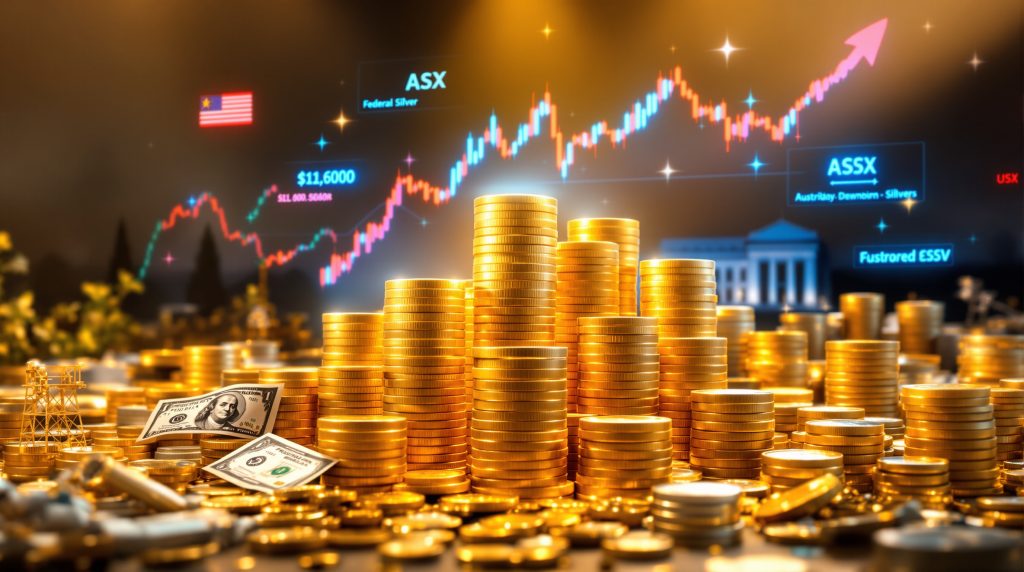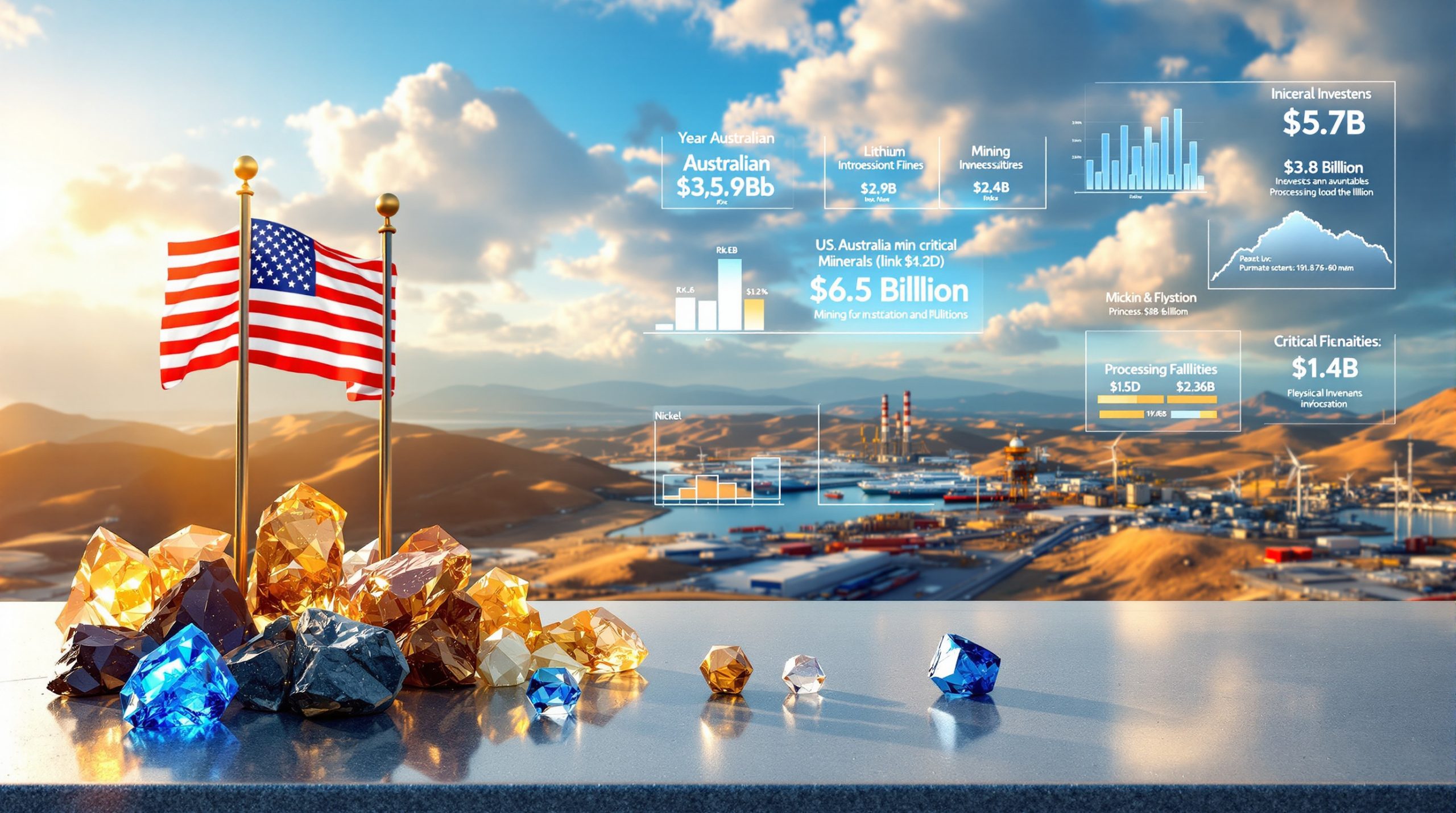The Perfect Storm: Gold and Silver Hit Record Highs and What It Means for Investors
Gold and silver prices have surged to unprecedented levels, capturing the attention of investors worldwide as these precious metals cement their status as premier safe-haven assets during times of economic uncertainty. With gold reaching historical peaks and silver hitting multi-year highs, the implications for investors, markets, and particularly Australian mining companies are profound and far-reaching.
What's Driving the Historic Rally in Precious Metals?
The Perfect Storm of Economic Factors
Global economic uncertainty has pushed safe-haven demand to extraordinary levels in recent months, creating ideal conditions for precious metals to flourish. This uncertainty stems from a confluence of factors that have collectively transformed the investment landscape.
A weakening US dollar has been particularly significant, creating favorable conditions for commodities priced in USD. The inverse relationship between the dollar and gold prices has amplified gold's upward trajectory, with every decline in the greenback translating to stronger precious metal performance.
Interest rate dynamics are playing a crucial role as well. Markets are closely watching the Federal Reserve's anticipated rate cuts, which traditionally reduce the opportunity cost of holding non-yielding assets like gold and silver. When interest-bearing investments offer diminishing returns, the relative attractiveness of precious metals increases substantially.
Persistent inflation concerns continue to support bullion prices, despite central bank efforts to control price growth. Historical data consistently shows that gold performs strongly during periods of elevated inflation, serving as a reliable store of value when fiat currencies lose purchasing power.
Political and institutional uncertainty has reinforced gold's traditional safe-haven role. Questions surrounding central bank independence have contributed to market nervousness, driving investors toward tangible assets with proven stability during turbulent times.
Breaking Down the Record Numbers
Current market data shows gold trading at historically significant levels, representing substantial year-to-date increases. The Australian dollar gold price has provided exceptional margins for domestic producers, creating a particularly favorable environment for ASX-listed mining companies.
Silver has demonstrated even more impressive performance, outpacing gold with remarkable percentage gains. This outperformance aligns with silver's historical pattern of exhibiting greater volatility than gold during bull markets, offering potentially higher returns alongside increased risk.
From a historical perspective, the current rally shares characteristics with previous bull markets but also exhibits unique features. Unlike past rallies that were often triggered by singular events, today's gold's all-time highs analysis reveals it is supported by multiple robust demand drivers acting simultaneously.
How Are Global Markets Responding to Precious Metals' Surge?
Central Bank Purchasing Trends
A major factor supporting gold prices has been the accelerating diversification away from US dollar reserves by central banks globally. This represents a significant shift in monetary policy worldwide, with implications extending far beyond the precious metals market.
Major buyers have emerged across various regions, each with strategic rationales driving their accumulation of gold reserves. Countries with historically strong ties to the US dollar are increasingly seeking to reduce dependence on a single reserve currency.
This central bank purchasing has fundamentally altered global gold supply-demand dynamics. Official sector buying has absorbed a substantial portion of available supply, creating upward price pressure even without corresponding increases in retail or institutional demand.
The long-term implications for monetary policy worldwide are profound. As central banks increase their gold holdings, they signal a potential shift in the international monetary system that could gradually reduce the US dollar's role as the predominant reserve currency.
Investment Flows Analysis
ETF holdings and institutional positioning have shown notable changes, reflecting shifting sentiment among professional investors. After periods of outflows, gold-backed exchange-traded products have seen renewed interest as economic uncertainties mount.
Retail investor participation rates have increased compared to previous rallies, driven partly by improved access through digital platforms and growing concerns about traditional financial systems. This broader base of investors potentially provides additional stability to the current bull market.
The geographic distribution of investment demand reveals interesting patterns, with particularly strong buying emerging from Asian markets. This regional diversity in demand sources contributes to the robustness of the current price trend.
Digital gold platforms have gained significant traction, though physical ownership trends remain strong among certain investor segments. This hybrid approach to precious metals ownership reflects the evolving preferences of modern investors who seek both convenience and tangible assets.
What Makes This Rally Different from Previous Bull Markets?
Macroeconomic Context Comparison
When contrasting current conditions with the 2011 and 2020 rallies, several key differences emerge. Unlike 2011, which was primarily driven by post-financial crisis quantitative easing, or 2020's pandemic-induced uncertainty, today's rally benefits from multiple concurrent catalysts.
The interest rate environment differs significantly from previous cycles. While past rallies often occurred against a backdrop of already low or falling rates, the current surge has persisted despite higher nominal interest rates, suggesting underlying strength in the fundamental case for precious metals.
Inflation expectations versus reality present another differentiating factor. Current inflation concerns are more deeply entrenched than during previous rallies, with persistent price pressures defying central bank forecasts for transitory inflation.
Geopolitical risk premiums have expanded considerably, contributing to gold's appeal as a crisis hedge. Regional conflicts, trade tensions, and questions about the global economic order have created a heightened sense of uncertainty that benefits safe-haven assets.
Technical Market Structure
Analysis of futures market positioning shows managed money and speculative positions at elevated but not extreme levels, suggesting potential room for additional investment flows before the market becomes overstretched.
Options market sentiment indicators reflect growing bullishness, with increased demand for call options at strike prices above current levels indicating expectations for continued upside.
Key resistance levels have been successively broken during the current rally, with each new high establishing fresh technical benchmarks. The gold price forecast 2025 continues to adjust upward as momentum builds and further support emerges.
Momentum indicators suggest the rally maintains strong underlying support despite periodic corrections. The balance between overbought conditions and fundamental drivers remains favorable for sustained price appreciation.
Which ASX Gold Producers Stand to Benefit Most?
Tier 1 Producers: Margin Expansion and Cash Flow Potential
Northern Star Resources (ASX: NST) has positioned itself advantageously with its diversified production profile across Australian and North American operations. With an all-in sustaining cost (AISC) significantly below current gold prices, the company is generating substantial free cash flow that supports both growth initiatives and shareholder returns.
Evolution Mining (ASX: EVN) demonstrates impressive asset quality across its portfolio, with operational efficiency metrics that consistently rank among the sector's best. The company's Evolution Mining expansion at Mungari has further strengthened its position in the Australian gold sector, creating a resilient business model that thrives in elevated gold price environments.
Gold Road Resources (ASX: GOR) offers compelling production outlook and expansion potential, anchored by its flagship Gruyere operation. The company's strong balance sheet and exploration upside provide multiple avenues for value creation in the current gold bull market.
Comparative analysis of all-in sustaining costs versus current gold prices reveals Australian producers generally enjoy wider margins than their global peers. This cost advantage stems from a combination of favorable geology, operational expertise, and in some cases, byproduct credits that offset production costs.
Emerging Mid-Tier Opportunities
Production growth trajectories among mid-tier producers show several companies poised for significant output increases over the next 12-24 months. These expansion plans, initiated during periods of lower gold prices, now stand to deliver enhanced returns in the current pricing environment.
Reserve replacement success rates vary considerably within this segment, with the most promising companies demonstrating consistent ability to replace depleted ounces through exploration or acquisition. This metric is crucial for sustainable long-term value creation.
Balance sheet strength comparison reveals significant differences in financial flexibility among mid-tier producers. Companies with lower debt levels and strong cash positions are best positioned to fund growth initiatives without dilutive equity raises.
Management track record assessment highlights the importance of experienced leadership teams with proven ability to deliver on operational promises. The best-performing mid-tier companies typically feature executives with successful histories at larger mining operations.
How Are Junior Explorers and Developers Positioned?
Development-Stage Companies
Barton Gold (ASX: BGD) has made significant progress on its project advancement timeline, with financing options expanding as gold prices strengthen. The company's strategic location in a proven gold district provides both geological upside and potential operational synergies.
Santana Minerals (ASX: SMI) continues to demonstrate remarkable resource growth potential through its exploration programs. Recent development milestones have increased market confidence in the company's ability to transition from explorer to producer.
Risk-reward profiles at current precious metals prices have improved substantially for development-stage companies. Projects that appeared marginal at lower gold prices now demonstrate robust economics, potentially accelerating development decisions.
The potential for M&A activity has increased as major producers seek reserve replacement to address production declines. Development-stage companies with defined resources in favorable jurisdictions represent attractive acquisition targets for larger miners looking to replenish their project pipelines.
Early-Stage Exploration Plays
High-potential exploration targets have attracted renewed investor interest, particularly projects in proven geological terrains with modern exploration approaches. The combination of established mineralization systems and contemporary exploration techniques creates compelling opportunities for discovery.
Drilling program updates and resource definition progress represent key value catalysts for early-stage companies. Positive drill results can drive significant revaluation, especially when they expand known mineralization or identify new zones.
Capital requirements versus current treasury positions highlight the financing challenges facing many explorers despite stronger gold prices. Companies with sufficient funding to complete meaningful exploration programs without immediate dilution offer better risk-adjusted potential.
Potential catalysts for revaluation include not only exploration success but also strategic partnerships, option agreements with larger companies, and jurisdictional developments that enhance project attractiveness.
What About the Silver Opportunity?
Industrial Demand Dynamics
The renewable energy sector represents a significant and growing source of silver demand. Photovoltaic installations continue to expand globally, with each solar panel requiring silver for optimal electrical conductivity. This structural demand driver operates largely independently of silver's investment characteristics.
Electronics manufacturing consumption trends remain robust despite efforts to reduce silver content per unit. The proliferation of electronic devices and growing complexity of components has sustained overall demand despite miniaturization and thrifting attempts.
Medical applications continue to expand as silver's antimicrobial properties find new uses in healthcare settings. From wound dressings to medical instruments, silver's unique properties create consistent demand that is relatively price-inelastic.
New technological applications are continually emerging, expanding silver's industrial demand base. The metal's exceptional thermal and electrical conductivity makes it indispensable in numerous high-performance applications where substitution is difficult or impossible.
Silver Miners vs. Gold-Silver Producers
Pure-play silver exposure options remain limited on global exchanges, with even fewer choices available on the ASX. This scarcity value can lead to premium valuations for companies offering focused exposure to silver price movements.
Byproduct credits significantly impact producer economics, with many primary gold miners benefiting from silver production that reduces their effective gold production costs. This relationship creates indirect silver exposure through gold-focused companies.
Production cost curve analysis reveals wide variability among silver producers, with the most efficient operations maintaining profitability even during price downturns. This operational resilience becomes less critical during strong bull markets but remains important for long-term investment considerations.
The leverage to continued price appreciation differs substantially between primary silver producers and gold miners with silver byproducts. Understanding these silver squeeze strategies can help investors make more informed decisions, as dedicated silver companies typically offer greater percentage gains during strong silver price advances, albeit with corresponding increased downside during corrections.
How Should Investors Approach Precious Metals in Their Portfolios?
Direct Investment Considerations
Physical metal ownership offers advantages including no counterparty risk and complete privacy, but comes with challenges related to storage, insurance, and liquidity. For significant allocations, secure storage solutions become an important consideration.
ETF alternatives provide convenient precious metals exposure without physical handling concerns. These instruments trade on stock exchanges with high liquidity, though they introduce counterparty and management risks not present with direct ownership.
Futures and options strategies offer sophisticated investors leveraged exposure and hedging capabilities. These derivative instruments require greater market knowledge and active management but can provide tactical advantages in volatile market conditions.
Tax implications vary significantly between different investment vehicles and jurisdictions. Physical metals, ETFs, mining shares, and derivatives each present distinct tax considerations that can materially impact after-tax returns.
Mining Equities Selection Framework
Valuation metrics most relevant in bull markets often differ from those emphasized during flat or bearish periods. While price-to-NAV and EV/EBITDA remain important, increasing attention shifts to exploration potential, production growth profiles, and jurisdictional advantages.
Balance sheet strength maintains its importance regardless of metal price environments. Companies with minimal debt and strong cash positions can better withstand potential price volatility while funding growth initiatives without shareholder dilution.
Management quality assessment should focus on teams with demonstrated capital allocation discipline and operational execution. The mining sector's history includes numerous examples of value destruction through poor project management or ill-timed acquisitions.
Developing effective investment strategies in gold requires careful consideration of ESG factors, which have become increasingly important in modern mining investments. Companies with strong environmental practices, community relationships, and governance structures typically command premium valuations and face fewer operational disruptions.
What Are the Key Risks to the Current Rally?
Potential Headwinds
US dollar strength scenarios represent a significant risk to precious metals prices. Any factors driving substantial dollar appreciation—such as relative economic outperformance or geopolitical crises that trigger flight-to-safety buying of US assets—could pressure gold and silver prices.
Federal Reserve policy pivot possibilities remain a crucial variable. If inflation proves more persistent than expected, forcing more aggressive monetary tightening, the resulting higher real interest rates could challenge the precious metals rally.
Technical correction likelihood increases after periods of rapid appreciation. Historical patterns suggest that even during strong bull markets, precious metals typically experience multiple 5-10% corrections that test investor conviction.
Profit-taking pressure tends to emerge at psychologically important price levels. Round numbers and previous all-time highs often act as temporary resistance as early investors liquidate positions to realize gains.
Market Sentiment Indicators to Monitor
Speculative positioning in futures markets provides valuable insight into market psychology. Extremely elevated speculative long positions can signal potential near-term tops, while unusual speculative short positioning often precedes sharp rallies.
Retail investor participation metrics help gauge the market cycle stage. Mainstream media coverage intensity and social media discussion volume typically peak near short-term tops but build gradually during sustained bull markets.
Media coverage intensity analysis shows increasing attention to precious metals as prices rise. This growing coverage attracts new investors but can also signal frothy conditions when it reaches extreme levels.
Contrarian signals worth monitoring include widespread public enthusiasm, dramatic price targets from analysts, and investment recommendations from non-financial sources. These indicators often emerge near significant interim tops.
What's Next for Gold and Silver Prices?
Expert Price Projections
Technical analysis-based targets suggest potential for continued upside in both gold and silver, with chart patterns indicating measured moves that exceed current price levels. These projections rely on historical price behavior patterns rather than fundamental factors.
Fundamental valuation models incorporating inflation expectations, interest rate projections, and currency trends generally support higher medium-term price targets. These models attempt to quantify the fair value of precious metals based on macroeconomic variables.
Historical comparison-based forecasts examine how similar market conditions affected previous bull markets. While past performance cannot guarantee future results, these analogues provide useful context for potential price behavior.
Potential price scenarios based on macroeconomic developments range from moderate continued appreciation to more dramatic upside if monetary conditions deteriorate substantially. Downside scenarios typically involve stronger-than-expected economic data and more aggressive monetary tightening.
Key Catalysts to Watch
Upcoming economic indicators will significantly influence precious metals markets. Particular attention should focus on inflation metrics, employment data, and GDP growth figures that might affect monetary policy decisions.
Federal Reserve meeting outcomes and accompanying statements provide crucial insights into future interest rate paths. Markets will scrutinize both policy decisions and the language used to describe economic conditions and policy intentions.
Geopolitical flashpoints can trigger rapid price movements in precious metals markets. Regional conflicts, trade disputes, and security threats often drive safe-haven buying that benefits gold and silver record highs.
Inflation data releases remain critical catalysts for precious metals. Persistent above-target inflation would likely support continued strength in gold and silver, while clear evidence of disinflation could challenge the bull case.
FAQ: Gold and Silver Investment Questions
How does gold perform during interest rate cutting cycles?
Historical performance analysis shows gold typically performs strongly during Federal Reserve easing cycles. This relationship stems from declining opportunity costs of holding non-yielding assets and the economic uncertainties that often prompt rate cuts.
Correlation strength with real interest rates (nominal rates minus inflation) provides more reliable signals than nominal rates alone. Negative or declining real rates create particularly favorable environments for precious metals.
Timing considerations suggest gold often begins rallying in anticipation of rate cuts rather than waiting for actual policy changes. This forward-looking characteristic means that waiting for confirmed rate reductions may miss significant portions of the price appreciation.
Duration effects on gold price momentum indicate that extended cutting cycles generally produce stronger precious metals performance than brief easing periods. The sustainability of accommodative monetary policy influences gold's long-term trend strength.
Is silver's industrial demand likely to sustain its price momentum?
Supply-demand balance projections suggest continued tightness in the silver market. Industrial consumption has shown remarkable resilience even during economic slowdowns, while mining production faces challenges from declining ore grades and environmental restrictions.
Key industrial growth sectors driving consumption include renewable energy, electronics, and medical applications. These sectors feature both strong growth trajectories and limited potential for silver substitution due to the metal's unique properties.
Substitution risk assessment indicates limited near-term threats to silver's industrial applications. While ongoing research seeks alternatives, silver's combination of electrical conductivity, thermal properties, and antimicrobial characteristics remains difficult to replicate cost-effectively.
The balance between investment demand and industrial consumption continues to define silver's price behavior. This dual nature creates more complex price dynamics than gold, with industrial demand providing a fundamental floor while investment flows drive major price movements.
What are the best ways to gain exposure to the gold and silver rally?
Direct ownership considerations include physical bullion, coins, and bars. These options eliminate counterparty risk but introduce storage and insurance requirements. The premium over spot price varies significantly between different physical products.
Mining equity selection strategies typically focus on producers with low costs, strong balance sheets, and quality assets in stable jurisdictions. These fundamentals become particularly important if precious metals prices experience significant volatility.
Royalty and streaming companies offer alternative exposure with reduced operational risks. These businesses provide upfront capital to miners in exchange for the right to purchase production at predetermined prices, creating leveraged exposure to metal prices without direct mining operational challenges.
Diversification approaches within the precious metals space might include combining physical metals, producing companies at various development stages, and royalty firms. This balanced approach reduces idiosyncratic risks while maintaining sector exposure.
How might currency fluctuations impact returns for Australian investors?
AUD/USD correlation with gold prices creates interesting dynamics for Australian investors. When the Australian dollar weakens against the USD during periods of economic stress, the AUD gold price often outperforms the USD gold price, enhancing returns for domestic investors.
Hedging considerations become relevant for international investors exposed to currency risk. Various instruments including futures, options, and currency-hedged ETFs allow investors to isolate precious metals exposure from currency movements.
Historical performance of gold in AUD terms has frequently exceeded USD performance during crisis periods. This pattern reflects Australia's commodity-linked currency, which typically weakens during global economic uncertainties, amplifying gold's safe-haven characteristics for Australian investors.
Portfolio allocation recommendations based on currency outlook should consider both the absolute level of precious metals exposure and the form of that exposure. During periods of anticipated AUD weakness, unhedged gold positions may provide both metal appreciation and currency benefits as noted by recent market analysis.
Ready to Benefit from the Next Major Mineral Discovery?
Stay ahead of the market with Discovery Alert's proprietary Discovery IQ model, which instantly notifies investors of significant ASX mineral discoveries and transforms complex data into actionable insights. Explore why historic discoveries can generate substantial returns by visiting Discovery Alert's dedicated discoveries page and begin your 30-day free trial today.




